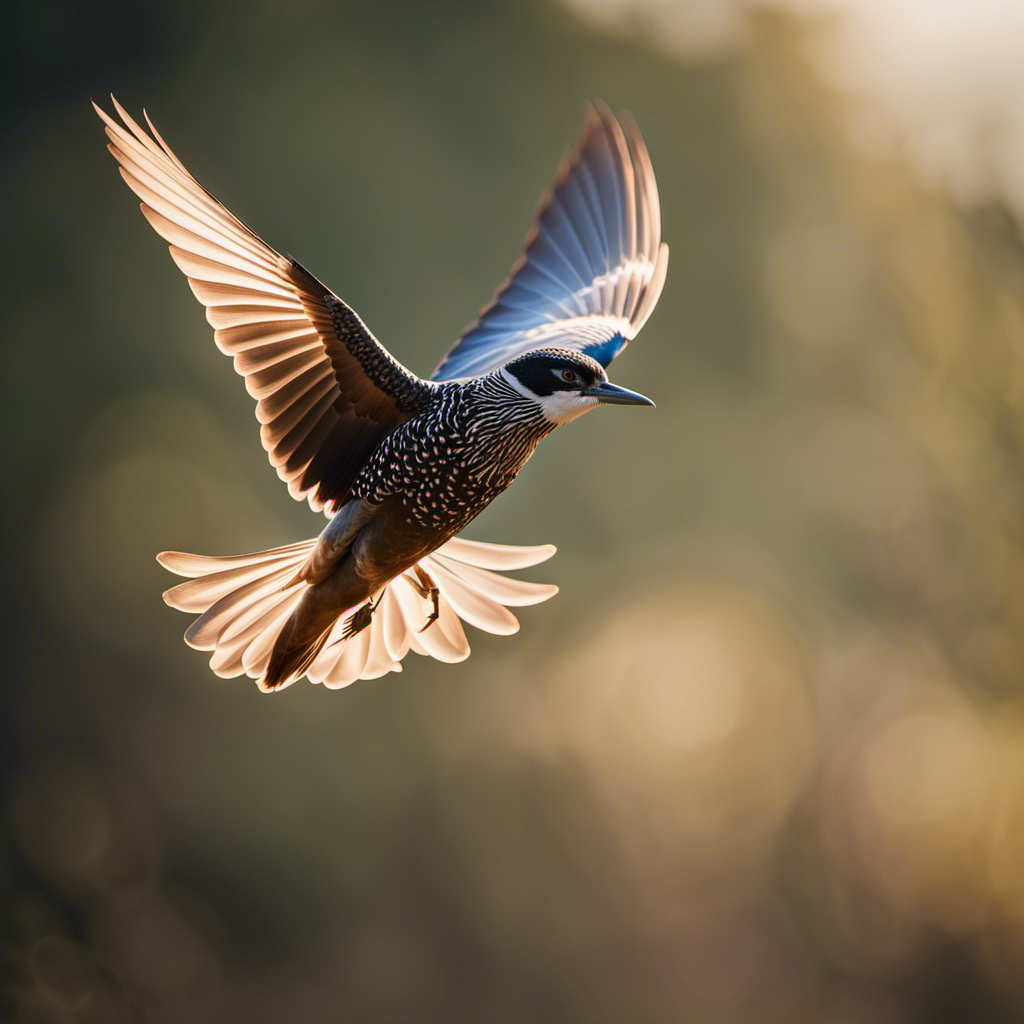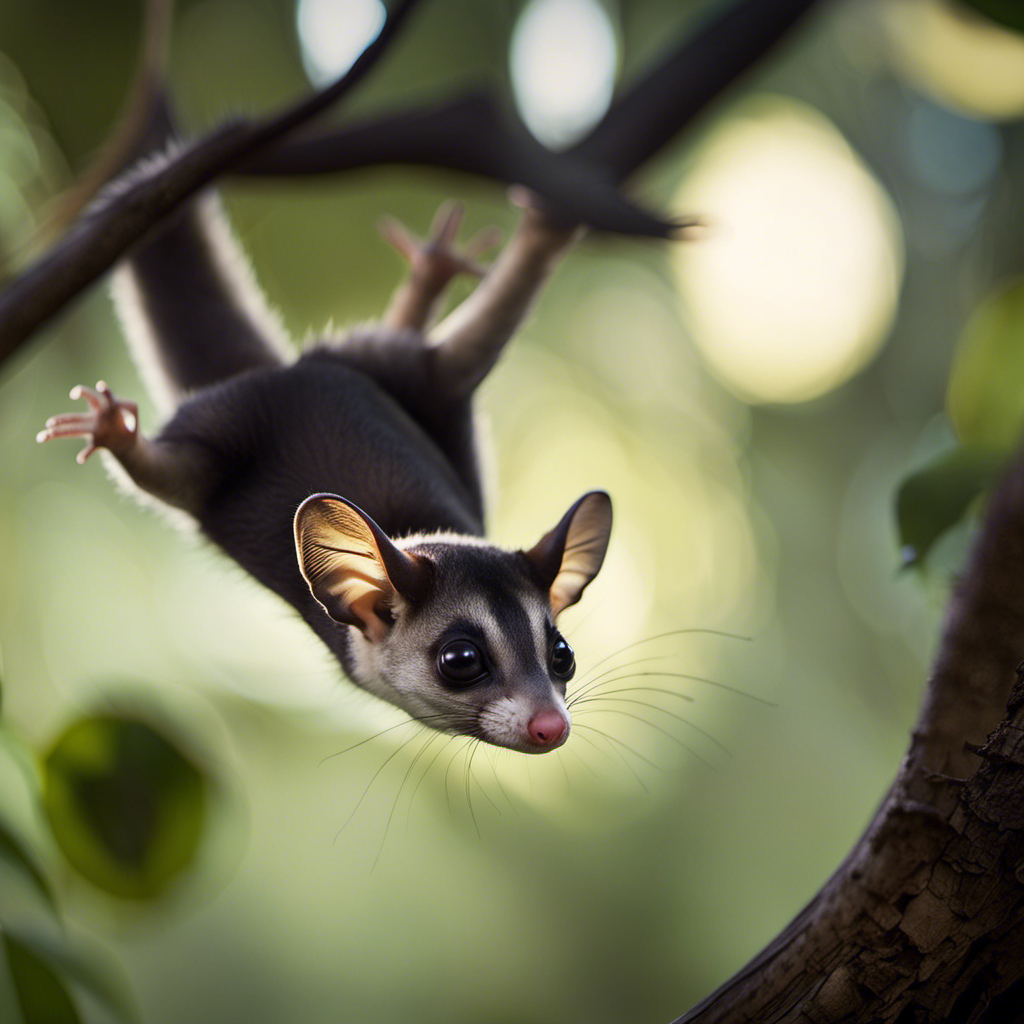The skill of aerial maneuvers, a superior ability among avian creatures, captivates me with its mysterious and majestic essence. How do these feathered creatures effortlessly soar through vast expanses of the atmosphere?
In this article, I embark on a scientific exploration into the world of soaring birds. By examining their anatomy, adaptations, and behavior, we unravel the secrets behind their airborne prowess.
From utilizing thermal updrafts to dynamic soaring, we delve into the fascinating techniques that enable birds to conquer the heavens and survive in diverse environments.
Key Takeaways
- Soaring birds can stay aloft for long periods without flapping their wings.
- They rely on thermal updrafts and air currents for flight.
- Soaring behavior allows them to conserve energy and cover long distances.
- Anatomical adaptations and techniques like circling within thermals and ridge soaring enhance their soaring abilities.
Types of Soaring Birds
If you look up in the sky, you’ll see a variety of soaring birds, such as hawks and eagles. These birds exhibit fascinating behavior and flight patterns that allow them to soar effortlessly through the air.
When it comes to bird behavior, soaring birds are known for their incredible ability to stay aloft for long periods of time without flapping their wings. They rely on thermal updrafts and air currents to gain altitude and maintain their flight. By circling within these columns of rising air, they can conserve energy and cover long distances.
They also have keen eyesight, which helps them spot prey from high in the sky. This behavior and flight pattern of soaring birds is a testament to their remarkable adaptations and anatomy, which we will explore in the next section.
Anatomy and Adaptations
The anatomy and adaptations of birds allow them to effortlessly glide through the air. Birds possess a unique set of anatomical adaptations that enable them to achieve flight. Their streamlined bodies, lightweight feathers, and powerful wing muscles all contribute to their ability to soar through the sky.
The shape of their wings, specifically their long and broad wingspan, helps to generate lift by creating air pressure differences. Additionally, the unique structure of their feathers allows for improved aerodynamics and maneuverability. Birds also possess a highly efficient respiratory system that enables them to extract oxygen from the air more effectively.
These anatomical adaptations, combined with their intricate flight mechanics, allow birds to navigate and maneuver in the air with great precision.
Transitioning into the subsequent section, birds have also developed the remarkable ability to utilize thermal updrafts to soar effortlessly.
Utilizing Thermal Updrafts
Understanding thermals is crucial for birds to effectively utilize them for soaring. Thermals are columns of rising air that occur due to temperature differences in the atmosphere.
Understanding Thermals
Birds can use thermals to soar effortlessly through the air. Understanding thermals is crucial for their aerial navigation.
Thermals are columns of warm air that rise from the Earth’s surface due to temperature differences. As the air near the ground gets heated, it becomes less dense and starts to rise, forming an updraft.
Birds take advantage of these rising air currents by circling within them. This allows them to gain altitude without exerting much energy.
Thermals are often found near areas with uneven heating, such as cliffs, mountains, or open fields. By understanding the behavior of thermals and how they form, birds can strategically navigate the sky and efficiently travel long distances.
With this knowledge, we can now explore the different soaring techniques birds employ within thermals.
Soaring Techniques in Thermals
To make the most of thermals, you can learn various techniques to efficiently ride the rising air currents. Understanding thermal dynamics and implementing effective aerial navigation skills are crucial in maximizing your soaring experience.
By carefully analyzing the thermal dynamics, such as the size, strength, and shape of the thermals, you can determine the best strategy for flying in them. This can involve circling within the thermal core to gain altitude or using the edges of the thermal to maintain a steady climb. Additionally, adjusting your bank angle and rate of turn can help you stay within the thermal and avoid being ejected from it.
Mastering these techniques allows you to harness the power of thermals and stay aloft for extended periods.
Transitioning to the next section about ‘ridge soaring,’ we can explore another fascinating method of utilizing natural air currents to stay airborne.
Ridge Soaring
Ridge soaring is a technique used by birds to harness the wind currents along mountain ridges. This method allows them to stay aloft for extended periods without flapping their wings. By flying close to the ridge, birds take advantage of the updrafts created when the wind hits the slope. They skillfully navigate these turbulent airflows, adjusting their wing positions to maintain altitude and glide effortlessly along the ridge.
Ridge flying is commonly observed in species such as raptors and seabirds, who rely on this technique to conserve energy during long-distance migrations. However, ridge soaring is not limited to mountain ridges; birds also employ this technique along coastal cliffs and escarpments. This ability to soar effortlessly in windy conditions is closely related to another fascinating flying technique known as dynamic soaring.
Dynamic Soaring
Dynamic soaring is a technique used by certain animals to harness the energy from wind gradients and maintain flight without flapping their wings. It is a remarkable adaptation that allows these animals to cover long distances during migration.
Here are three fascinating aspects of dynamic soaring:
-
Energy efficiency: Dynamic soaring takes advantage of the varying wind speeds and directions at different altitudes. By flying in a zigzag pattern, animals can exploit wind gradients and extract energy from the air. This allows them to travel long distances with minimal effort.
-
Speed and stability: Dynamic soaring can enable animals to reach impressive speeds, sometimes exceeding 100 miles per hour. The technique also provides stability during flight, allowing for precise control and maneuverability in challenging wind conditions.
-
Adaptations: Animals that utilize dynamic soaring, such as certain seabirds and albatrosses, have evolved specific anatomical features, such as long, narrow wings and streamlined bodies. These adaptations enhance their ability to soar and glide effectively, maximizing their efficiency during long-distance migration.
Using Updrafts from Slopes and Cliffs
When it comes to utilizing the power of updrafts, slope soaring and cliff soaring are two techniques that come to mind.
Slope soaring involves harnessing the wind that is forced upwards when it encounters a slope or hill. This upward movement creates a lift that can be used by gliders and other aircraft to gain altitude and extend their flight time.
Similarly, cliff soaring takes advantage of the wind that is deflected upwards when it hits a cliff or a steep rock face.
Slope Soaring
Slope soaring is popular among pilots who enjoy using the natural slope of hills to gain altitude. As a pilot myself, I have always been fascinated by the intricate dance between the wind and the terrain during slope soaring. The wind patterns that form along the slope of a hill play a crucial role in this type of flying. Here are three key wind patterns that pilots need to be aware of when slope soaring:
-
Ridge lift: This occurs when the wind hits the face of the slope and is forced to rise. As it rises, it creates an updraft that can be used by pilots to gain altitude.
-
Thermals: In addition to ridge lift, thermals can also form along the slope. These are pockets of warm air that rise due to heating from the sun. When pilots encounter a thermal, they can use it to climb higher.
-
Rotors: Rotors are turbulent areas of air that can form on the leeward side of the slope. These can be dangerous for pilots, as they can create strong downdrafts and turbulence.
Understanding these wind patterns is essential for successful slope soaring.
Transitioning into the next section about ‘cliff soaring,’ it is interesting to note the similarities and differences in wind patterns between the two types of soaring.
Cliff Soaring
Transitioning into cliff soaring, it’s fascinating to explore the unique wind patterns that pilots encounter along the rugged cliffs. These wind patterns are influenced by various factors, such as the shape and orientation of the cliffs, the surrounding topography, and the prevailing weather conditions.
The uplift created by the wind hitting the cliffs can provide an optimal environment for soaring, allowing birds and glider pilots to gain altitude and maintain flight without flapping their wings. Cliff soaring requires a high level of skill and precision, as pilots must navigate the turbulent air currents and thermals that are often present near the cliffs. This type of soaring is commonly practiced in mountainous regions, where cliffs and steep slopes are abundant.
As we delve deeper into the concept of cliff soaring, it becomes evident that it is closely related to mountain soaring, as both rely on the same principles of utilizing air currents to maintain flight. Understanding the intricacies of wind patterns and airflow around cliffs and mountains is crucial for successful soaring experiences. With this knowledge, pilots can harness the power of the wind to effortlessly glide through the skies.
Transitioning to the next topic, long-distance migration, birds rely on their soaring abilities to cover vast distances in search of suitable habitats and resources.
Long-Distance Migration
If you want to understand long-distance migration in birds, you should consider the incredible ability of soaring.
Long distance navigation is a complex task that requires precise physiological adaptations. Birds have evolved various mechanisms to navigate across vast distances, including using celestial cues, magnetic fields, and landmarks.
Physiological adaptations such as increased red blood cell count, larger heart size, and efficient oxygen utilization enable birds to sustain flight for long periods. These adaptations allow them to cover thousands of kilometers during migration, often crossing entire continents or even oceans.
Soaring Behavior and Communication
When studying the behavior and communication of birds, three important aspects to consider are group soaring, vocalizations, and visual signals.
Group soaring refers to the behavior of birds flying together in a coordinated manner, often in a V-formation. This behavior has been observed in various bird species, such as geese and pelicans, and is believed to provide aerodynamic benefits and facilitate communication within the group.
Vocalizations play a crucial role in bird communication, with different species having their own unique calls and songs that serve various purposes, including attracting mates, defending territories, and warning of potential danger.
Additionally, birds also use visual signals, such as displays of plumage or body postures, to communicate with each other and convey information about their intentions, status, or territorial boundaries.
Understanding these aspects of bird behavior and communication can provide valuable insights into their social dynamics and ecological interactions.
Group Soaring
To understand group soaring, picture yourself soaring through the sky with a flock of birds. It is a magnificent sight to witness the synchronized flight of a group of birds, each moving in harmony with the others. Group dynamics play a crucial role in this phenomenon, as birds rely on social interactions to maintain their formation.
Here are some fascinating aspects of group soaring:
-
Leadership: Within the flock, there is usually a lead bird that sets the course and speed for the rest to follow.
-
Communication: Birds communicate through vocalizations and visual signals, enabling them to coordinate their movements and maintain their formation.
-
Cooperative thermals: Birds take advantage of rising columns of warm air, called thermals, by flying in a circular pattern within them. This cooperative behavior allows them to gain altitude and conserve energy.
By understanding the intricacies of group dynamics and social interactions, we can further appreciate the remarkable abilities of birds in their collective aerial journeys.
In the next section, we will explore the significance of vocalizations and visual signals in their communication repertoire.
Vocalizations and Visual Signals
As we explored the fascinating phenomenon of group soaring, I couldn’t help but wonder about the communication strategies employed by these birds.
Curiosity led me to delve into the vocalization patterns and visual signaling used during their soaring journeys.
Research has revealed that vocalizations play a crucial role in coordinating group movements and maintaining social cohesion. Birds utilize a variety of calls, ranging from soft chirps to loud screeches, to convey information about their intentions, location, and even potential threats.
Additionally, visual signals, such as body postures, wing movements, and feather displays, act as visual cues that facilitate coordination and maintain spatial awareness within the group.
These intricate communication systems allow birds to navigate the skies in a synchronized manner, ensuring efficient and effective soaring.
Now, let’s explore the fascinating soaring techniques employed by birds in different environments.
Soaring Techniques in Different Environments
When it comes to soaring techniques, birds have adapted to various environments such as the coast, desert, and forest.
Coastal soaring involves birds taking advantage of the updrafts created by the wind blowing over the ocean and the coastal terrain.
In desert soaring, birds utilize thermals, or columns of warm air, that rise from the hot desert ground to gain altitude and glide effortlessly through the arid landscape.
In forest soaring, birds navigate through the dense canopy, using updrafts created by the wind passing through the trees and taking advantage of the varied topography.
Coastal Soaring
Birds on coastal areas often engage in soaring to take advantage of the updrafts and thermals created by the ocean breeze. This behavior is driven by their innate behavioral patterns and feeding habits. As a researcher, I have observed this fascinating phenomenon and studied its intricate details. Here are some key findings:
- Soaring allows birds to cover large distances with minimal energy expenditure.
- It enables them to access food sources that are otherwise difficult to reach.
- Soaring promotes social interactions among birds, facilitating mating and breeding.
- The breathtaking aerial displays during coastal soaring evoke a sense of awe and wonder.
- The rhythmic movements of the birds in the coastal updrafts create a mesmerizing spectacle.
Transitioning into the next section about ‘desert soaring,’ I have also explored how birds adapt their soaring techniques in arid environments to survive and thrive.
Desert Soaring
You might be surprised to learn that desert landscapes offer unique opportunities for flight and exploration.
In the desert, soaring birds take advantage of desert thermals and the specific wind patterns that can be found in these arid regions. Desert thermals are columns of rising air that are heated by the sun-warmed desert floor. These thermals provide the necessary lift for birds to stay aloft and travel long distances.
Additionally, desert wind patterns, such as the prevailing winds and thermal breezes, can create dynamic air currents that birds can use to their advantage. By harnessing these desert thermals and wind patterns, birds are able to soar effortlessly through the vast desert expanse.
This ability to soar in the desert opens up a whole new world of flight and exploration.
Transitioning into the subsequent section about ‘forest soaring’, birds that can soar in the desert also possess the skills to navigate and soar in forested environments.
Forest Soaring
Exploring forest landscapes offers a whole new level of adventure and discovery. The forest habitat is a complex and diverse ecosystem, teeming with life and intricate interactions.
When it comes to birds, the forest provides a unique environment for aerial acrobatics. In the dense vegetation, birds utilize their wings to navigate through the trees, twisting and turning with precision and grace. From the agile hummingbird to the majestic eagle, these avian creatures have adapted their flight techniques to suit the challenges of the forest.
Soaring as a survival strategy allows birds to conserve energy while covering large distances in search of food and mates. This efficient mode of flight enables them to effortlessly glide between tree canopies, providing an advantage in the competitive forest environment.
Soaring as a Survival Strategy
Gliding through the air is a survival strategy that many birds use to conserve energy. Soaring behavior is a fascinating adaptation that allows birds to travel long distances without expending excessive energy. Here are three key ways in which soaring serves as a vital survival technique:
-
Efficient flight: Soaring birds take advantage of rising air currents, such as thermals and updrafts, to gain altitude and maintain their position in the sky. This minimizes the need for flapping their wings, reducing energy expenditure.
-
Extended foraging range: By soaring, birds can cover vast distances in search of food. They can effortlessly survey large areas and locate prey or food sources, increasing their chances of survival.
-
Migration facilitation: Soaring enables birds to undertake long-distance migrations by conserving energy during the journey. By riding on air currents, they can travel thousands of kilometers without exhaustion, ensuring their survival in different habitats and seasons.
Understanding the intricate mechanisms behind soaring behavior provides valuable insights into avian survival techniques and enhances our appreciation for the remarkable abilities of these aerial creatures.
Frequently Asked Questions
What are the different types of birds that do not engage in soaring behavior?
Birds that cannot soar include flightless species like penguins and ostriches. Additionally, some birds, such as pigeons and doves, are known for their gliding abilities rather than soaring.
How do birds communicate with each other during soaring flights?
During soaring flights, birds communicate with each other using a combination of vocalizations and visual cues. Vocalizations include calls and songs, which can convey information about territory, food sources, and mating. Visual cues such as body postures and wing movements also play a role in communication.
What are some specific techniques that birds use to soar in mountainous environments?
In mountainous environments, birds use specific techniques to soar. They take advantage of thermals and wind currents to gain altitude, utilize gliding techniques to maintain flight, and have specialized wing morphology that enhances their soaring abilities.
Are there any dangers or risks associated with soaring for birds?
There are dangers and risks associated with soaring for birds. These include collisions with other birds or obstacles, exhaustion from long flights, and exposure to extreme weather conditions.
How do birds navigate and orient themselves during long-distance migrations while soaring?
Birds navigate and orient themselves during long-distance migrations by utilizing thermals and wind patterns. They ride the rising columns of warm air, known as thermals, to gain altitude and then use prevailing wind directions to guide their flight.
Conclusion
In conclusion, after delving into the world of soaring birds, it is evident that they possess remarkable adaptations and techniques that allow them to effortlessly glide through the skies.
From utilizing thermal updrafts and ridge soaring to dynamic soaring and long-distance migration, these birds have honed their skills to perfection.
Their ability to communicate and navigate in different environments showcases their intelligence and resilience.
So, next time you see a soaring bird high up in the sky, have you ever wondered what it would be like to effortlessly ride the wind currents and experience the freedom of flight?
With a heart that soars as high as the skies, Aria, affectionately known as “Skylark,” is the driving force behind Soaring Skyways. Her journey into the gliding world began as a young dreamer gazing up at the soaring birds, yearning to experience the weightlessness and freedom they embodied. With years of experience both in the cockpit and behind the scenes, Aria’s commitment to the gliding community is unwavering.










